Most Beautiful Hydrangea Varieties to Grow in Your Garden
Published: September 9, 2025 at 2:30:57 PM UTC
Hydrangeas are among the most beloved flowering shrubs, captivating gardeners with their spectacular blooms and versatile growing habits. From the classic mophead varieties with their massive spherical flowers to the elegant panicle types with cone-shaped clusters, these stunning plants offer endless possibilities for garden beauty. In this guide, we'll explore the most beautiful hydrangea varieties that can transform your garden into a showcase of color and texture throughout the growing season.
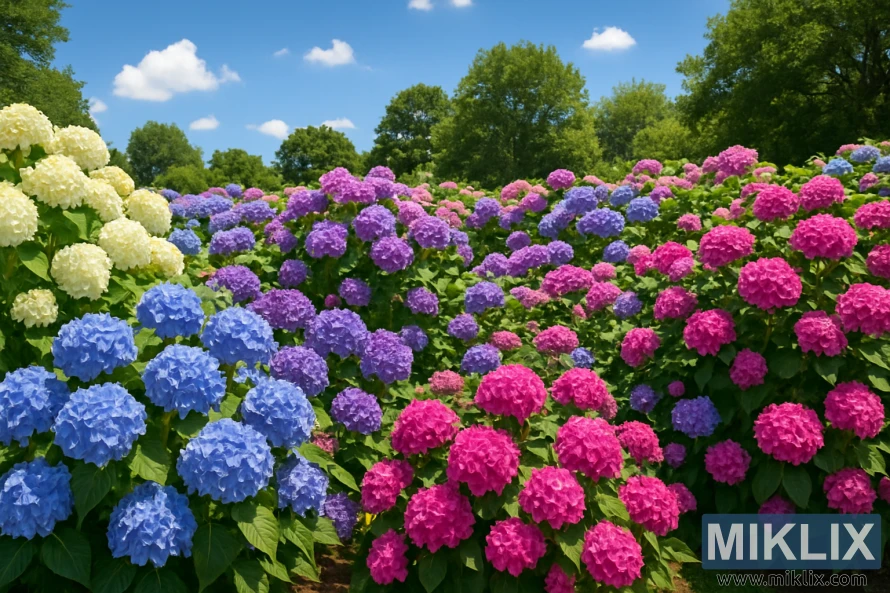
Breathtaking Bigleaf Hydrangeas (Hydrangea macrophylla)
Bigleaf hydrangeas are perhaps the most recognized type, featuring those classic rounded flower clusters in shades of blue, pink, purple, or white. Their color can change based on soil pH, making them fascinating additions to any garden landscape.
1. 'Endless Summer' - The Reliable Rebloomer
This revolutionary variety blooms on both old and new wood, ensuring flowers throughout the growing season even after harsh winters. 'Endless Summer' produces large, globe-shaped flowers that can be blue in acidic soil or pink in alkaline conditions.
- Growing requirements: Part shade (morning sun, afternoon shade); well-draining, moist soil; USDA zones 4-9
- Design tips: Perfect as a foundation planting, in mixed borders, or as a focal point in partly shaded areas
- Special features: Reblooms throughout summer and into fall; color can be manipulated with soil amendments

2. 'Nikko Blue' - Classic Blue Beauty
A timeless favorite known for its intensely blue, large mophead flowers when grown in acidic soil. The vibrant blooms create a stunning display against the glossy, dark green foliage.
The intense blue blooms of 'Nikko Blue' create a dramatic garden focal point
- Growing requirements: Part shade; moist, well-draining soil with pH below 5.5 for blue flowers; USDA zones 6-9
- Design tips: Excellent for woodland gardens, coastal landscapes, or as a specimen plant
- Special features: Exceptional cut flowers; dramatic color impact when planted in groups

3. 'Pistachio' - Unique Multi-Colored Wonder
This extraordinary variety features unique bi-colored blooms with a blend of green, pink, and burgundy tones. Each mophead flower cluster looks like a bouquet in itself, creating a truly distinctive garden presence.
- Growing requirements: Morning sun, afternoon shade; rich, well-draining soil; USDA zones 5-9
- Design tips: Use as a conversation-starting focal point or in containers where its unusual coloration can be appreciated up close
- Special features: Color changes throughout the season; no two blooms look exactly alike
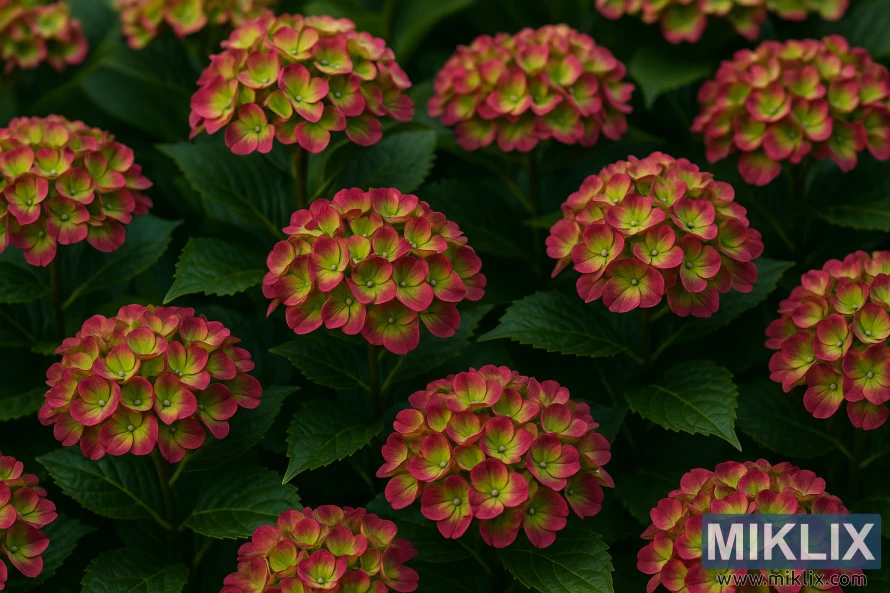
Elegant Panicle Hydrangeas (Hydrangea paniculata)
Panicle hydrangeas are prized for their cone-shaped flower clusters and exceptional hardiness. These versatile shrubs thrive in more sun than other hydrangea types and offer dramatic late-summer color that often transitions beautifully into fall.
The show-stopping 'Limelight' hydrangea with its distinctive lime-green blooms
4. 'Limelight' - Dramatic Color Transformer
This award-winning variety produces large, cone-shaped flower clusters that emerge lime-green in summer, transition to creamy white, then develop pink and burgundy tones in fall. The sturdy stems hold the heavy blooms upright, creating a magnificent display.
- Growing requirements: Full sun to part shade; adaptable to various soil types; USDA zones 3-8
- Design tips: Excellent as a hedge, screen, or focal point; stunning in mass plantings
- Special features: Exceptionally cold-hardy; flowers hold their shape well for dried arrangements
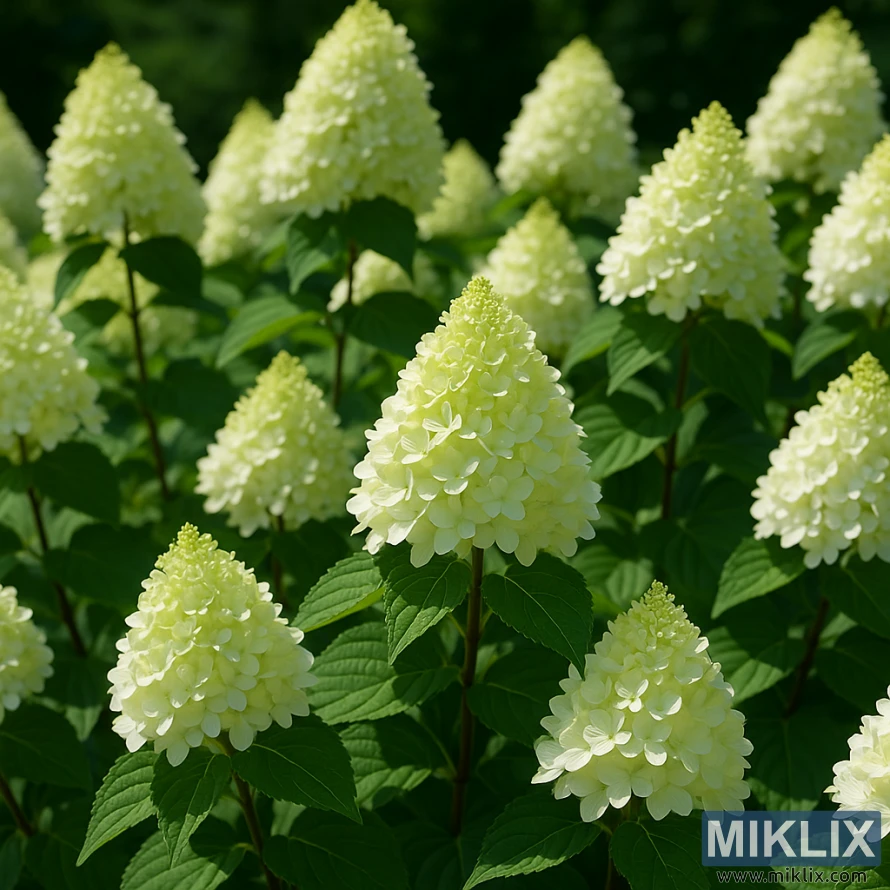
5. 'Quick Fire' - The Early Bloomer
Blooming up to a month before other panicle varieties, 'Quick Fire' extends the hydrangea season with white flowers that quickly transition to deep pink-red. This creates a long-lasting display from early summer through fall.
'Quick Fire' hydrangea showing its beautiful color progression from white to deep pink
- Growing requirements: Full sun to part shade; adaptable to most soil types; USDA zones 3-8
- Design tips: Perfect for extending the flowering season; pairs beautifully with ornamental grasses
- Special features: Earliest blooming panicle variety; excellent fall color; attracts pollinators
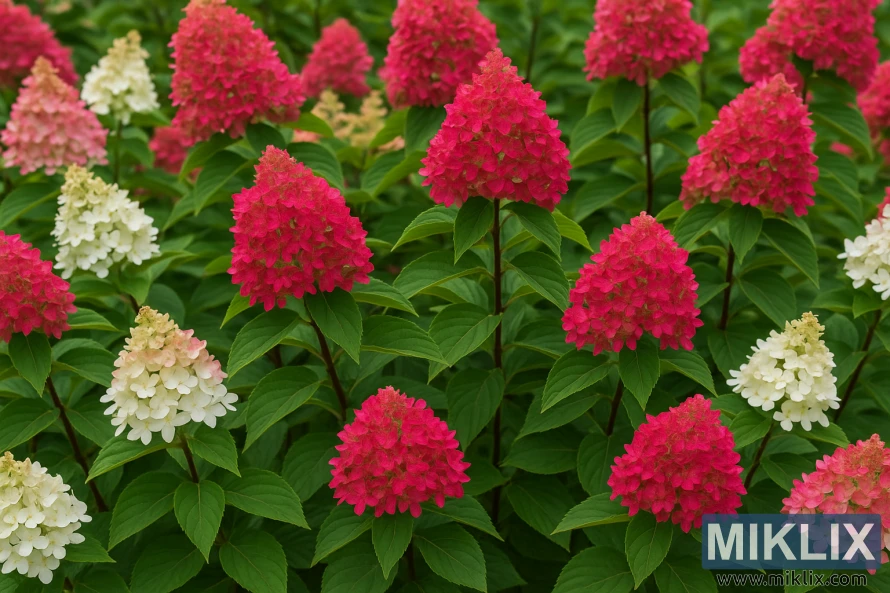
6. 'Little Lime' - Compact Powerhouse
A dwarf version of 'Limelight' that packs the same visual punch in a smaller package. Growing just 3-5 feet tall and wide, 'Little Lime' produces an abundance of lime-green flowers that age to pink and burgundy.
- Growing requirements: Full sun to part shade; well-draining soil; USDA zones 3-8
- Design tips: Perfect for small gardens, containers, or as a low hedge
- Special features: Compact size without sacrificing flower power; sturdy stems resist flopping
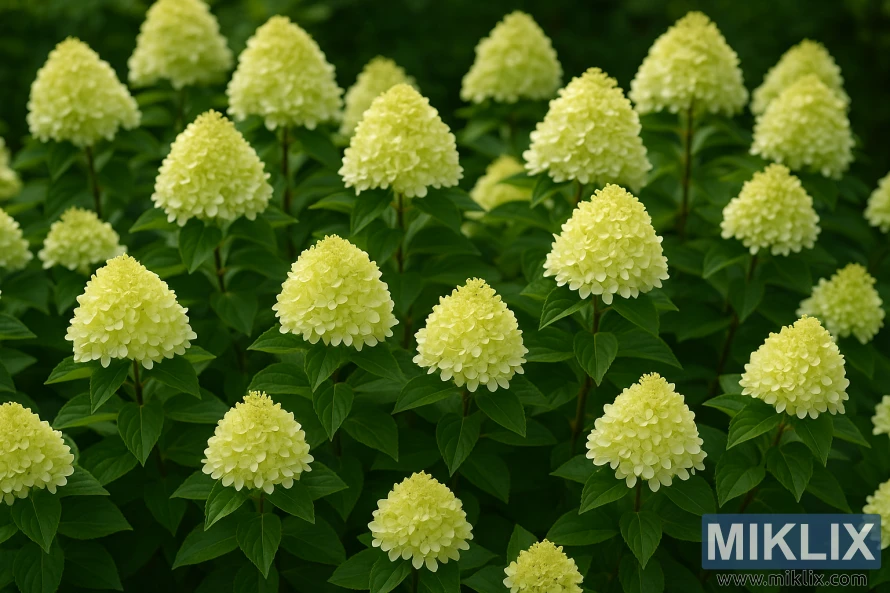
Stunning Smooth Hydrangeas (Hydrangea arborescens)
Native to North America, smooth hydrangeas are exceptionally hardy and produce spectacular rounded flower clusters. These reliable bloomers flower on new wood, making them perfect for colder climates where other hydrangeas might struggle.
The classic 'Annabelle' hydrangea with its impressive white snowball blooms
7. 'Annabelle' - The Classic Beauty
This beloved classic produces enormous, snow-white flower heads up to 12 inches across that bloom reliably even after harsh winters. The flowers emerge green, mature to pure white, then age to a soft green again in late summer.
- Growing requirements: Part shade to full shade; moist, well-draining soil; USDA zones 3-9
- Design tips: Spectacular in woodland gardens, as a hedge, or massed beneath trees
- Special features: Native plant; extremely cold hardy; excellent cut flowers
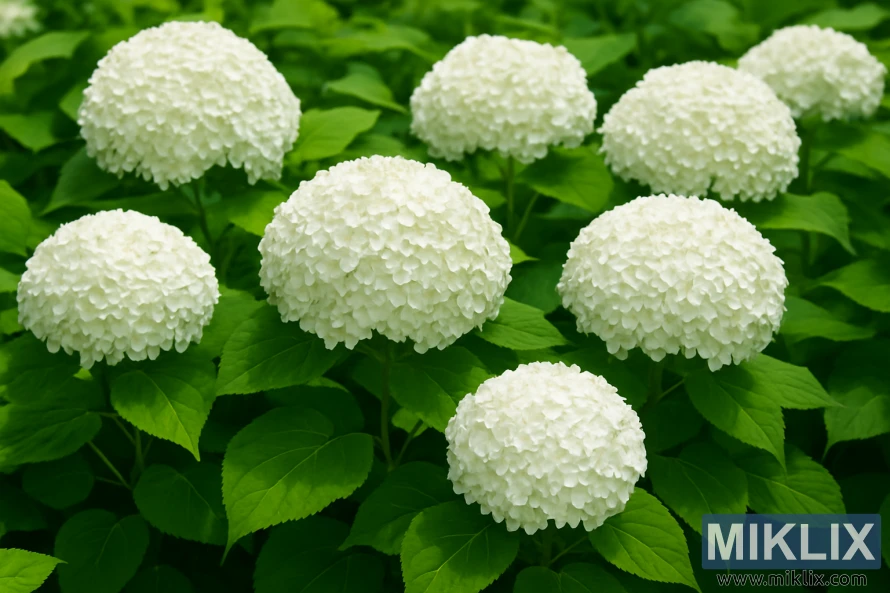
8. 'Incrediball' - Massive Blooms on Strong Stems
An improved 'Annabelle' with stronger stems that prevent flopping, 'Incrediball' produces truly enormous white flower heads up to 12 inches in diameter. The sturdy stems hold the massive blooms upright even after summer rainstorms.
'Incrediball' hydrangea showcases improved stem strength to support its massive blooms
- Growing requirements: Part shade; moist, well-draining soil; USDA zones 3-9
- Design tips: Excellent as a focal point or in mass plantings; creates dramatic impact
- Special features: Improved stem strength; reliable bloomer; drought tolerant once established
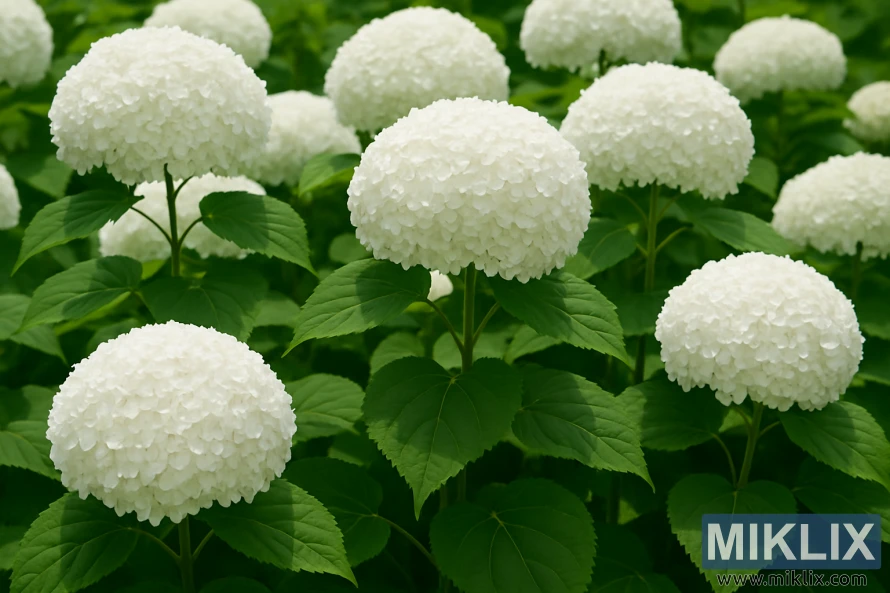
9. 'Invincibelle Ruby' - Stunning Red Blooms
This breakthrough variety brings rich ruby-red color to smooth hydrangeas. The dark burgundy buds open to ruby-red flowers that mature to a soft silvery-pink, creating a multi-colored display throughout the season.
- Growing requirements: Part shade; rich, well-draining soil; USDA zones 3-9
- Design tips: Use as a colorful accent in mixed borders or woodland edges
- Special features: Unique red coloration; reblooms throughout summer; attracts butterflies
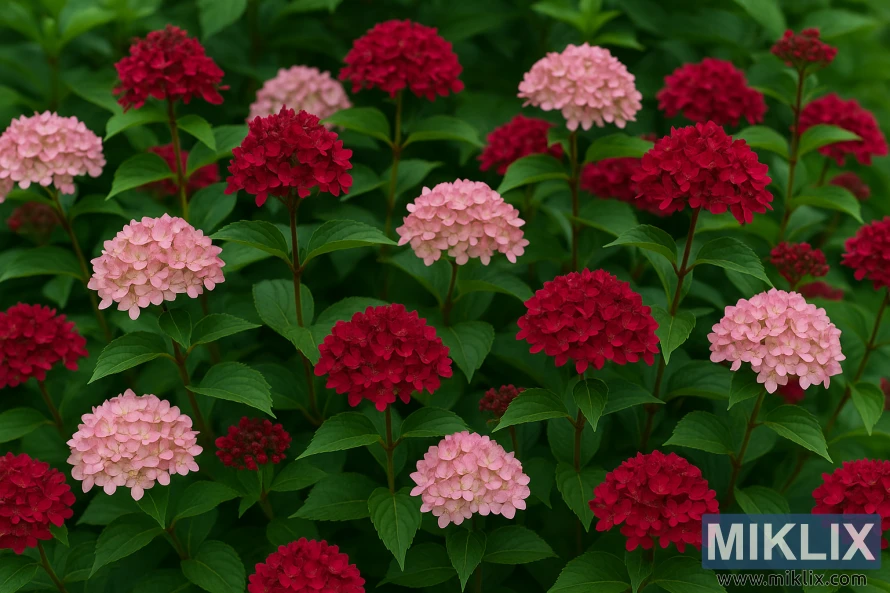
Distinctive Oakleaf Hydrangeas (Hydrangea quercifolia)
Oakleaf hydrangeas stand out with their unique, lobed leaves that resemble oak tree foliage. These native North American shrubs offer four-season interest with spectacular fall color, exfoliating bark, and dramatic flower panicles.
'Snow Queen' oakleaf hydrangea showcases its distinctive oak-shaped leaves and elegant white blooms
10. 'Snow Queen' - Elegant and Enduring
This outstanding selection features large, 8-12 inch long flower panicles that emerge white and gradually take on rose-pink tones as they age. The flowers hold their upright position well, and the foliage turns brilliant mahogany-red in fall.
- Growing requirements: Part shade; well-draining soil; USDA zones 5-9
- Design tips: Excellent for woodland gardens, naturalized areas, or as a specimen plant
- Special features: Four-season interest with flowers, fall color, and exfoliating bark in winter
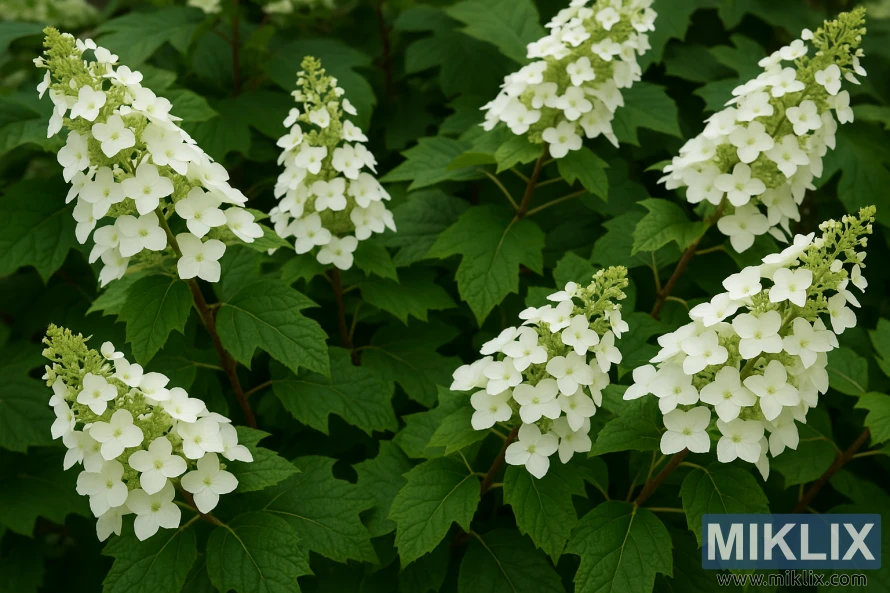
11. 'Ruby Slippers' - Compact Color Changer
A compact oakleaf variety perfect for smaller gardens, 'Ruby Slippers' produces white flowers that quickly turn pale pink and deepen to ruby-red as they mature. The compact habit makes this variety more versatile in garden design.
'Ruby Slippers' oakleaf hydrangea demonstrates its beautiful color transition from white to ruby-red
- Growing requirements: Part shade; well-draining soil; USDA zones 5-9
- Design tips: Perfect for small gardens, foundation plantings, or mixed borders
- Special features: Compact size (3-4 feet); dramatic flower color change; excellent fall foliage
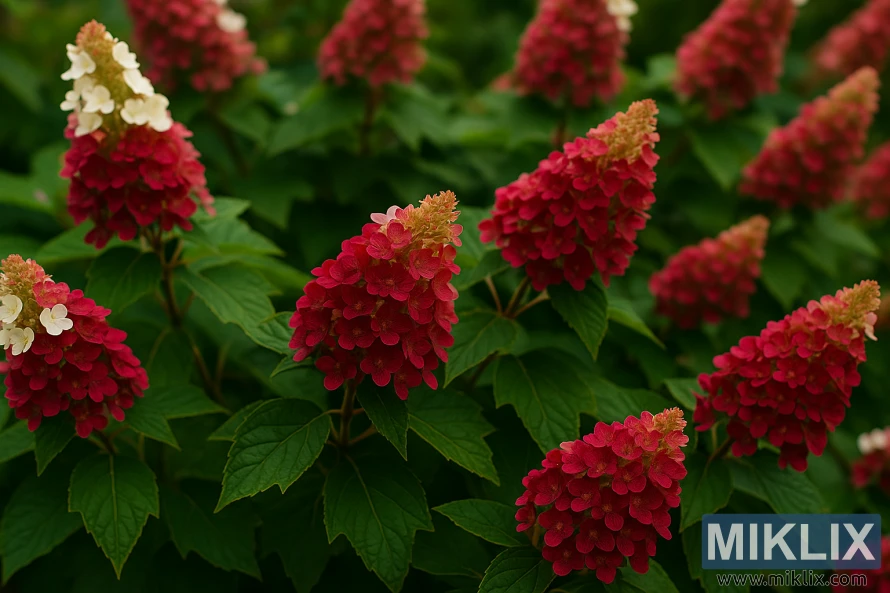
Spectacular Climbing Hydrangeas (Hydrangea petiolaris)
Climbing hydrangeas bring vertical drama to the garden with their ability to scale walls, fences, and trees. These unique vines produce lacy, flat flower clusters and feature attractive exfoliating bark for winter interest.
Climbing hydrangea creating a stunning vertical display on a garden wall
12. Hydrangea petiolaris - The Classic Climber
This versatile climber can reach 30-40 feet in height and produces 8-10 inch wide, flat white flower clusters in early summer. The rich green heart-shaped leaves turn yellow in fall, and the cinnamon-colored exfoliating bark provides winter interest.
- Growing requirements: Part to full shade; moist, well-draining soil; USDA zones 4-8
- Design tips: Excellent for covering north or east-facing walls, garden structures, or tree trunks
- Special features: Self-clinging via aerial rootlets; provides habitat for birds; long-lived once established
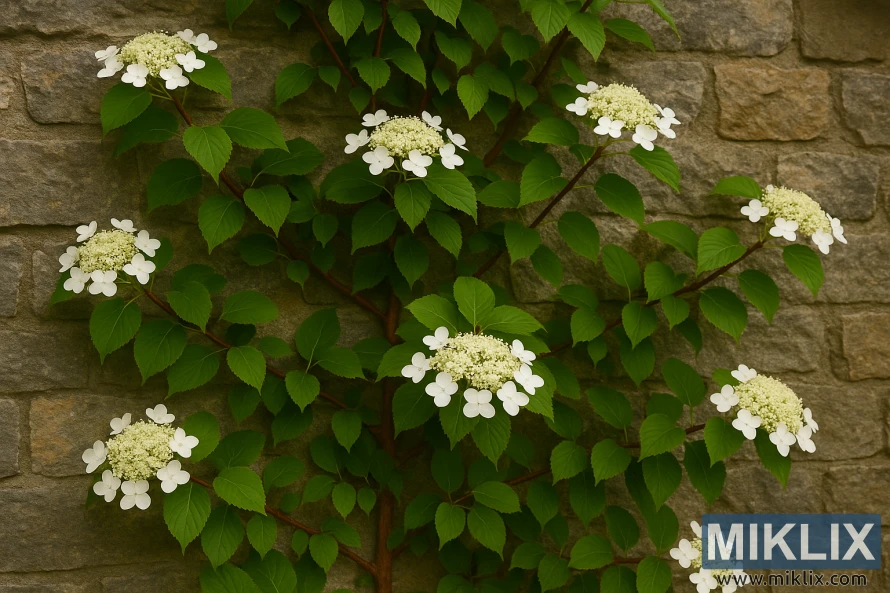
13. 'Miranda' - Variegated Beauty
This striking variety features green leaves edged with creamy yellow variegation, adding extra visual interest even when not in bloom. The white lacecap flowers appear in early summer against the colorful foliage.
- Growing requirements: Part shade; moist, well-draining soil; USDA zones 4-8
- Design tips: Use to brighten shady walls or as a groundcover in woodland settings
- Special features: Variegated foliage; slower growing than the species; excellent for smaller spaces
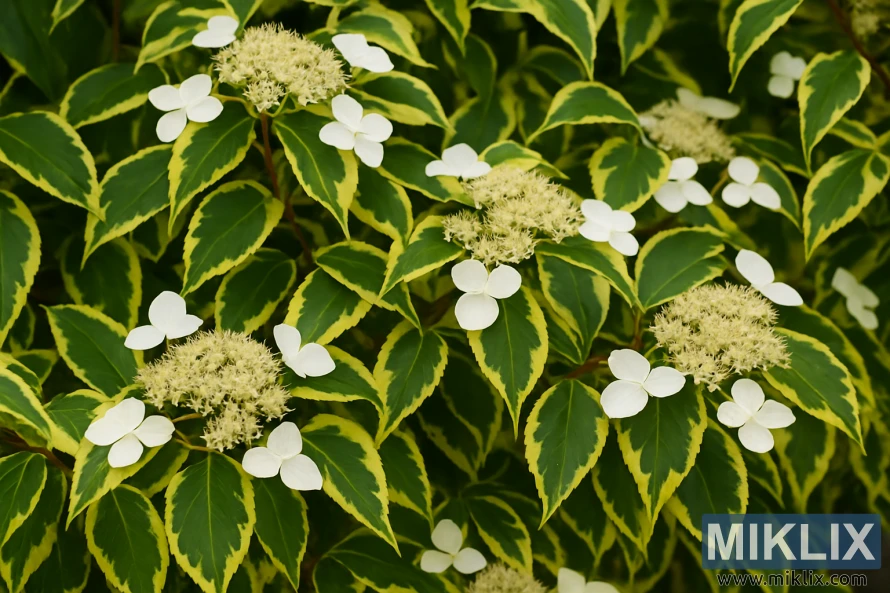
Delicate Mountain Hydrangeas (Hydrangea serrata)
Mountain hydrangeas offer a more refined, delicate appearance than their bigleaf cousins. Native to the mountains of Japan and Korea, these elegant shrubs feature lacecap flowers and are often more cold-hardy than bigleaf varieties.
14. 'Blue Billow' - Delicate Blue Lacecaps
This charming variety produces delicate blue lacecap flowers with fertile center florets surrounded by showy sterile florets. The serrated leaves turn burgundy-red in fall, adding seasonal interest.
- Growing requirements: Part shade; moist, acidic soil; USDA zones 5-9
- Design tips: Perfect for woodland gardens, Asian-inspired landscapes, or containers
- Special features: More cold-hardy than many bigleaf types; attracts pollinators; excellent fall color
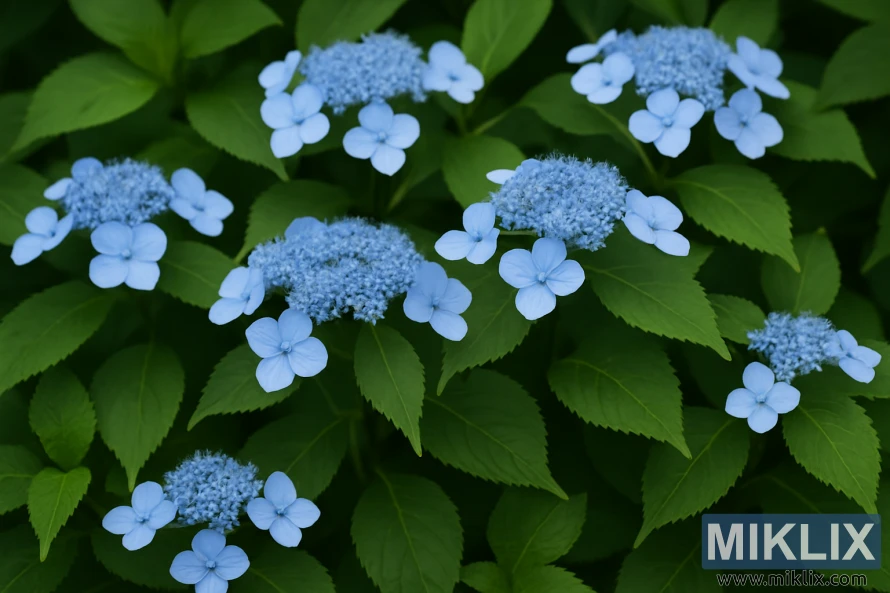
15. 'Tuff Stuff' - Reblooming Mountain Hydrangea
This breakthrough variety blooms on both old and new wood, ensuring flowers even after harsh winters. The lacecap flowers emerge pink in alkaline soil or blue in acidic conditions and continue to appear throughout the growing season.
'Tuff Stuff' mountain hydrangea offers reliable blooms and excellent fall color
- Growing requirements: Part shade; well-draining soil; USDA zones 5-9
- Design tips: Excellent for small gardens, containers, or as a low hedge
- Special features: Reblooming; more cold-hardy than bigleaf types; red fall foliage
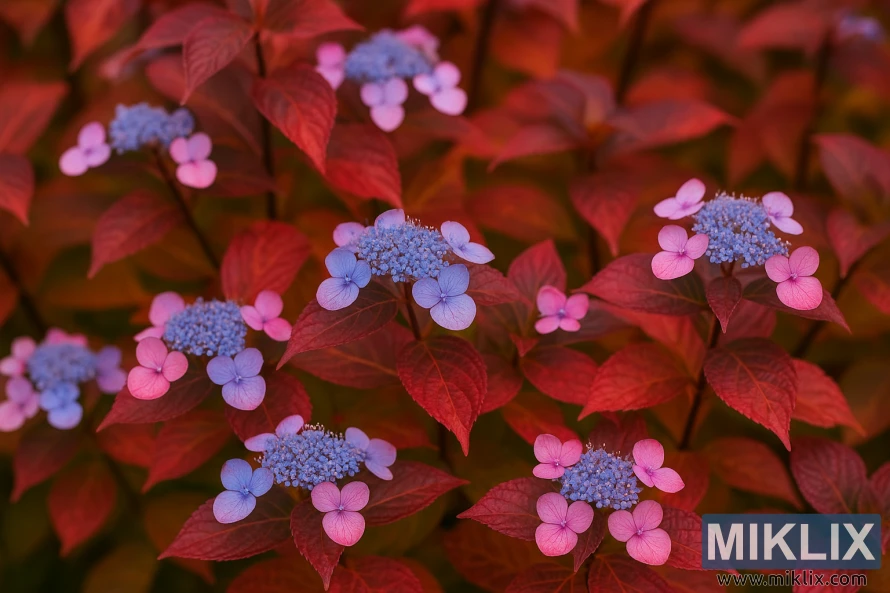
Perfect Companion Plants for Hydrangeas
Enhance your hydrangea display by pairing these beautiful shrubs with complementary plants that share similar growing requirements and create visual harmony.
A harmonious garden composition featuring hydrangeas with hostas and Japanese forest grass
Shade-Loving Companions
- Hostas - Provide contrasting foliage texture and thrive in similar conditions
- Ferns - Add delicate, feathery texture that complements hydrangea blooms
- Astilbe - Offers vertical flower spikes in complementary colors
- Heuchera - Colorful foliage adds interest when hydrangeas aren't blooming
Sun-Loving Companions
- Ornamental Grasses - Create movement and contrast with hydrangea blooms
- Coneflowers - Attract pollinators and provide late-summer color
- Russian Sage - Offers airy purple blooms that complement hydrangeas
- Daylilies - Provide bold color and thrive in similar conditions
Shrub Companions
- Japanese Maples - Provide elegant structure and fall color
- Boxwood - Creates formal structure around looser hydrangea forms
- Azaleas - Offer spring blooms before hydrangeas take center stage
- Viburnum - Complements hydrangeas with similar flower forms
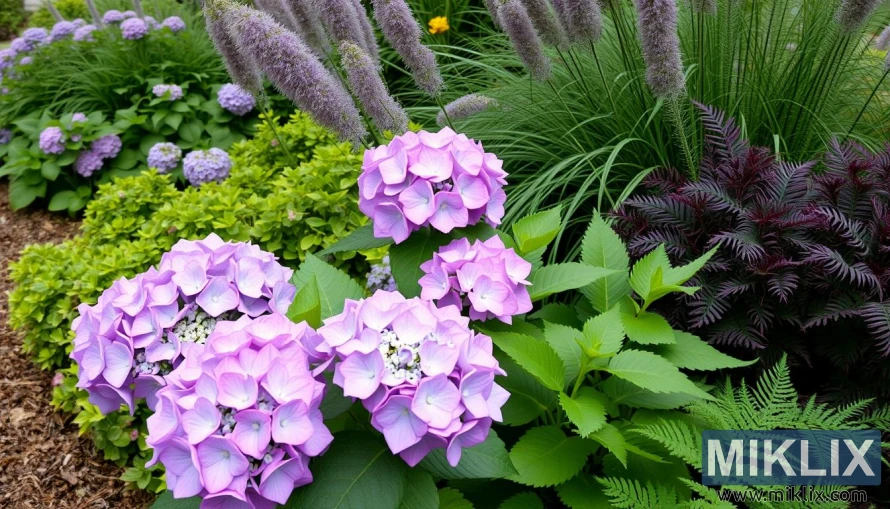
Maintaining Vibrant Hydrangea Blooms
Keep your hydrangeas looking their best with these essential care tips for spectacular blooms year after year.
Proper pruning technique is essential for maintaining healthy, blooming hydrangeas
Pruning Guidelines
- Bigleaf & Mountain: Prune after flowering in summer, removing only spent blooms
- Panicle & Smooth: Prune in late winter/early spring before new growth appears
- Oakleaf: Minimal pruning needed; remove dead wood in early spring
- Climbing: Prune only to control size after flowering
Soil & Fertilizer
- Soil pH: Test and adjust for desired flower color in bigleaf varieties
- Fertilizer: Apply balanced, slow-release fertilizer in spring
- Mulch: Apply 2-3 inches to retain moisture and suppress weeds
- Avoid: High-nitrogen fertilizers that promote foliage over flowers
Water & Protection
- Watering: Deep, infrequent watering is better than frequent shallow watering
- Winter protection: Apply mulch around base for cold-sensitive varieties
- Shade: Provide afternoon shade in hot climates to prevent wilting
- Deadheading: Remove spent blooms to encourage new flowers in reblooming varieties
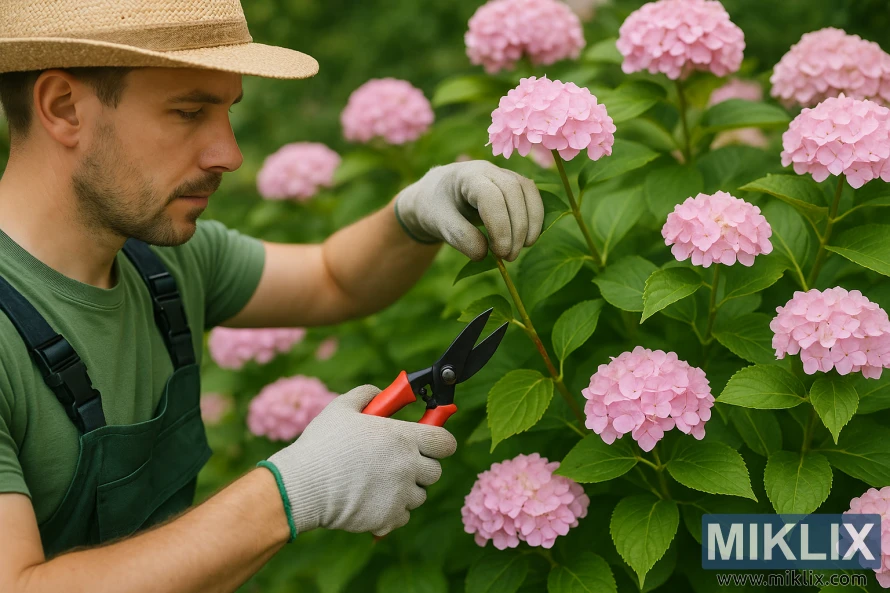
Conclusion
With their spectacular blooms, diverse forms, and adaptability to various garden conditions, hydrangeas offer endless possibilities for creating breathtaking garden displays. Whether you choose the classic bigleaf varieties with their color-changing abilities, the hardy panicle types for reliable summer color, or the unique oakleaf selections for four-season interest, these magnificent flowering shrubs will reward you with years of beauty.
Start with one or two varieties that match your garden conditions, then expand your collection as you discover the joy of growing these versatile plants. Remember that proper placement, consistent care, and appropriate pruning will ensure the most spectacular blooms year after year. Your garden deserves the timeless elegance and show-stopping beauty that only the most beautiful hydrangea varieties can provide.
Further Reading
If you enjoyed this post, you may also like these suggestions:
- A Guide to the Most Beautiful Rose Varieties for Gardens
- A Guide to the Most Beautiful Zinnia Varieties to Grow in Your Garden
- 15 Most Beautiful Flowers to Grow in Your Garden
